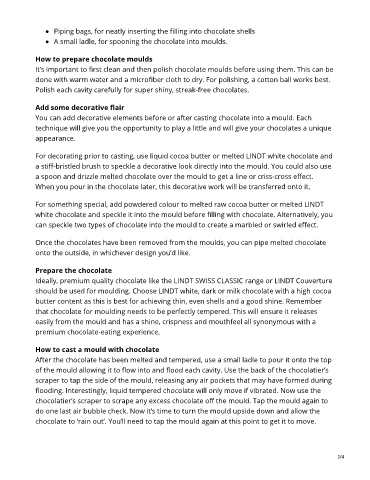Page 612 - YC Cooking School
P. 612
Piping bags, for neatly inserting the filling into chocolate shells
A small ladle, for spooning the chocolate into moulds.
How to prepare chocolate moulds
It’s important to first clean and then polish chocolate moulds before using them. This can be
done with warm water and a microfiber cloth to dry. For polishing, a cotton ball works best.
Polish each cavity carefully for super shiny, streak-free chocolates.
Add some decorative flair
You can add decorative elements before or after casting chocolate into a mould. Each
technique will give you the opportunity to play a little and will give your chocolates a unique
appearance.
For decorating prior to casting, use liquid cocoa butter or melted LINDT white chocolate and
a stiff-bristled brush to speckle a decorative look directly into the mould. You could also use
a spoon and drizzle melted chocolate over the mould to get a line or criss-cross effect.
When you pour in the chocolate later, this decorative work will be transferred onto it.
For something special, add powdered colour to melted raw cocoa butter or melted LINDT
white chocolate and speckle it into the mould before filling with chocolate. Alternatively, you
can speckle two types of chocolate into the mould to create a marbled or swirled effect.
Once the chocolates have been removed from the moulds, you can pipe melted chocolate
onto the outside, in whichever design you’d like.
Prepare the chocolate
Ideally, premium quality chocolate like the LINDT SWISS CLASSIC range or LINDT Couverture
should be used for moulding. Choose LINDT white, dark or milk chocolate with a high cocoa
butter content as this is best for achieving thin, even shells and a good shine. Remember
that chocolate for moulding needs to be perfectly tempered. This will ensure it releases
easily from the mould and has a shine, crispness and mouthfeel all synonymous with a
premium chocolate-eating experience.
How to cast a mould with chocolate
After the chocolate has been melted and tempered, use a small ladle to pour it onto the top
of the mould allowing it to flow into and flood each cavity. Use the back of the chocolatier’s
scraper to tap the side of the mould, releasing any air pockets that may have formed during
flooding. Interestingly, liquid tempered chocolate will only move if vibrated. Now use the
chocolatier’s scraper to scrape any excess chocolate off the mould. Tap the mould again to
do one last air bubble check. Now it’s time to turn the mould upside down and allow the
chocolate to ‘rain out’. You’ll need to tap the mould again at this point to get it to move.
2/4

